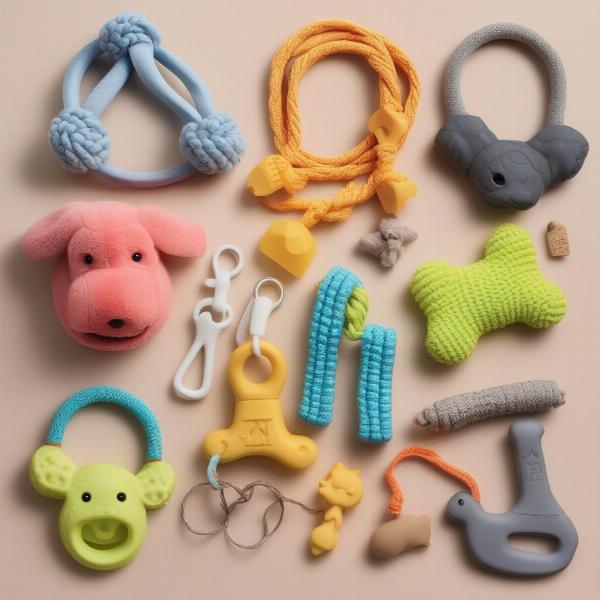Teething is a crucial stage in a puppy’s development, and choosing the right dog teething toys can make all the difference. Providing appropriate chew toys not only soothes their sore gums but also helps establish good chewing habits and prevents destructive behavior. This guide will cover everything you need to know about dog teething toys, from understanding the teething process to choosing the best toys for your furry friend.
Understanding the Teething Process in Puppies
Puppies begin teething around 3-4 weeks of age, and the process continues until they are about 6-7 months old. During this time, their baby teeth (deciduous teeth) erupt and are eventually replaced by permanent adult teeth. This can be a painful and uncomfortable experience for puppies, leading to excessive chewing, drooling, and even slight fever.
What are the signs of teething in puppies?
- Excessive chewing on anything they can find
- Drooling more than usual
- Whining or whimpering
- Swollen or red gums
- Difficulty eating
- Sometimes, a slight fever
Choosing the Right Dog Teething Toys
Selecting the appropriate teething toys is vital for your puppy’s health and well-being. The right toy can provide comfort, promote healthy dental development, and prevent damage to your belongings.
What to look for in a teething toy:
- Durability: The toy should be able to withstand vigorous chewing without breaking apart or posing a choking hazard.
- Size: Choose toys that are appropriately sized for your puppy to prevent swallowing.
- Material: Look for non-toxic, durable materials like rubber, nylon, or silicone.
- Texture: Toys with different textures can provide varied stimulation and help soothe sore gums.
- Freezable options: Some toys can be frozen to provide extra cooling relief for inflamed gums.
 Variety of Dog Teething Toys
Variety of Dog Teething Toys
Types of Teething Toys:
- Rubber toys: These are often durable and come in various shapes and sizes. Some have textured surfaces for added gum massage.
- Rope toys: These can help clean teeth and massage gums while also providing a satisfying chewing experience.
- Freezable toys: Filled with water or gel, these toys can be chilled in the freezer to provide soothing relief for sore gums.
- Nylabones: These durable nylon toys are specifically designed for chewing and can help satisfy a puppy’s natural urge to gnaw.
Why are teething toys important?
Teething toys are more than just playthings; they are essential tools for your puppy’s development. Providing appropriate chew toys can help redirect their chewing instincts away from your furniture, shoes, and other valuable items.
“Teething is a crucial stage for puppies,” says Dr. Emily Carter, DVM, “Providing them with safe and effective teething toys is essential for their comfort and dental health. It also helps prevent destructive chewing behaviors down the line.”
Caring for Your Puppy’s Teeth
Even with teething toys, regular dental care is essential. Introduce your puppy to toothbrushing early on and use a dog-specific toothpaste. Regular veterinary check-ups are also important for monitoring dental health.
“Establishing a dental care routine from a young age is vital for maintaining your dog’s oral health throughout their life,” adds Dr. Carter. “This includes regular brushing and professional dental cleanings as recommended by your veterinarian.”
Conclusion
Choosing the right dog teething toys is an important step in ensuring your puppy’s comfort and well-being during the teething process. By providing appropriate chew toys, you can help soothe their sore gums, promote healthy dental development, and prevent destructive chewing habits. Remember to choose durable, non-toxic toys and always supervise your puppy during playtime. Teething can be a challenging time, but with the right tools and a little patience, you can help your puppy navigate this stage with ease.
FAQ
- When do puppies start teething? Puppies typically start teething around 3-4 weeks of age.
- How long does the teething process last? Teething usually continues until puppies are about 6-7 months old.
- What are signs of teething in puppies? Excessive chewing, drooling, swollen gums, and difficulty eating are common signs.
- What types of teething toys are best? Durable rubber toys, rope toys, and freezable toys are good choices.
- How can I care for my puppy’s teeth during teething? Provide appropriate teething toys, introduce toothbrushing, and schedule regular veterinary check-ups.
- Can teething toys prevent destructive chewing? Yes, teething toys can help redirect chewing instincts away from your belongings.
- What should I do if my puppy’s teething seems excessive? Consult your veterinarian to rule out any underlying dental issues.
ILM Dog is your trusted source for expert advice on dog care and well-being. We offer a comprehensive range of resources covering breed selection, health care, training, nutrition, grooming, and much more. Whether you’re a new dog owner or a seasoned pro, we’re here to help you navigate every stage of your dog’s life. burger dog toy are a fun option, and learning about the dental formula for dogs can be helpful. We also have great resources on chew resistant dog bed to help protect your furniture while your puppy teethes. Additionally, explore our selection of dog cage accessories and the no chew dog harness for further support. Contact us today at [email protected] or +44 20-3965-8624 to learn more about how ILM Dog can support your journey as a dog owner.